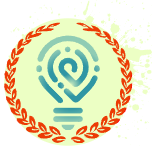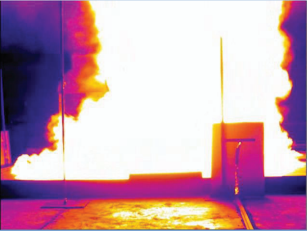Nathaniel C. Horn
Chemical Engineer | Data Analyst
Nathanielchorn@nchsande.com
(603) 748 - 6694
Panama City, FL
Summary
Nathaniel Horn is a chemical engineer who has been actively engaged with the fire research group at Tyndall Air Force Base for two years. With experience in process engineering, firefighting, scuba diving, design, programming, 3D printing, and web design, Nathaniel’s educational background is in chemical engineering, environmental engineering, and nuclear engineering. His passion for comprehending systems, processes, and environmental conditions to enhance efficiency and reduce pollution fuels his work as a ‘forever student’ who is eager to learn and tackle any challenge.
Work Experience
Chemical Research Engineer
- Utilized Excel, MATLAB, Python, and Ruby to analyze complex thermal and ecological databases.
- Implemented waste water reduction systems based on schematic reviews and system designs for reducing PFAS contaminated water.
- Manage the ordering and staging of caustic chemicals, ensured proper HAZWAP procedures were followed.
- Managed subcontractors or visitors and report progress to management and customers.
Chemical Process Engineer
- Managed three key processes – phosphate coating, adhesive application, and post-treatment, resulting in a efficient operational for multiple customer products.
- Define the process for 50+ new or obsolete customer products to be processed within current production systems.
- Develop product tracking software that pulls information from operation systems, shipping and reciving to sales data.
- Use Problem solving methods (six-sigma, RedX and statistics) to determine solutions for complex process issues.
Manufacturer | Project Manager
- Oversaw the structuring and flow dynamics of the production area, resulting in a 50% increase in production efficiency and part traceability.
- Traveled to customer locations to install, upgrade, or resolve current issues.
- Assembled, shipped and repaired computer components for customers.
Internship Experience
Manufacturing Engineer Intern
- Manufacture low-demand liquid medications following standard operating procedures in a clean room environment.
- Review manufacturing plans to determine for errors or corrections.
- Operated reactors, chromatography skids, and liquid separation systems
Chemical Engineer Intern
- Assisted in the development of 8 specialized UV ink for use within the food industry, including formulation, testing, upscaling, and refinement process.
- Perform quality control test on production, prototypes and custom order inks.
- Assisted in managing and stocking 60+ chemicals used in ink production
Volunteer Experience
Fire Fighter | EMT
- Be available within 24hrs Responded to fires, accidents, and other incidents where risk are posed to life and/or property.
- Regularly perform equipment inspection and practice drills.
Additional Information
- Certifications
- Papers
- Projects
Certifications
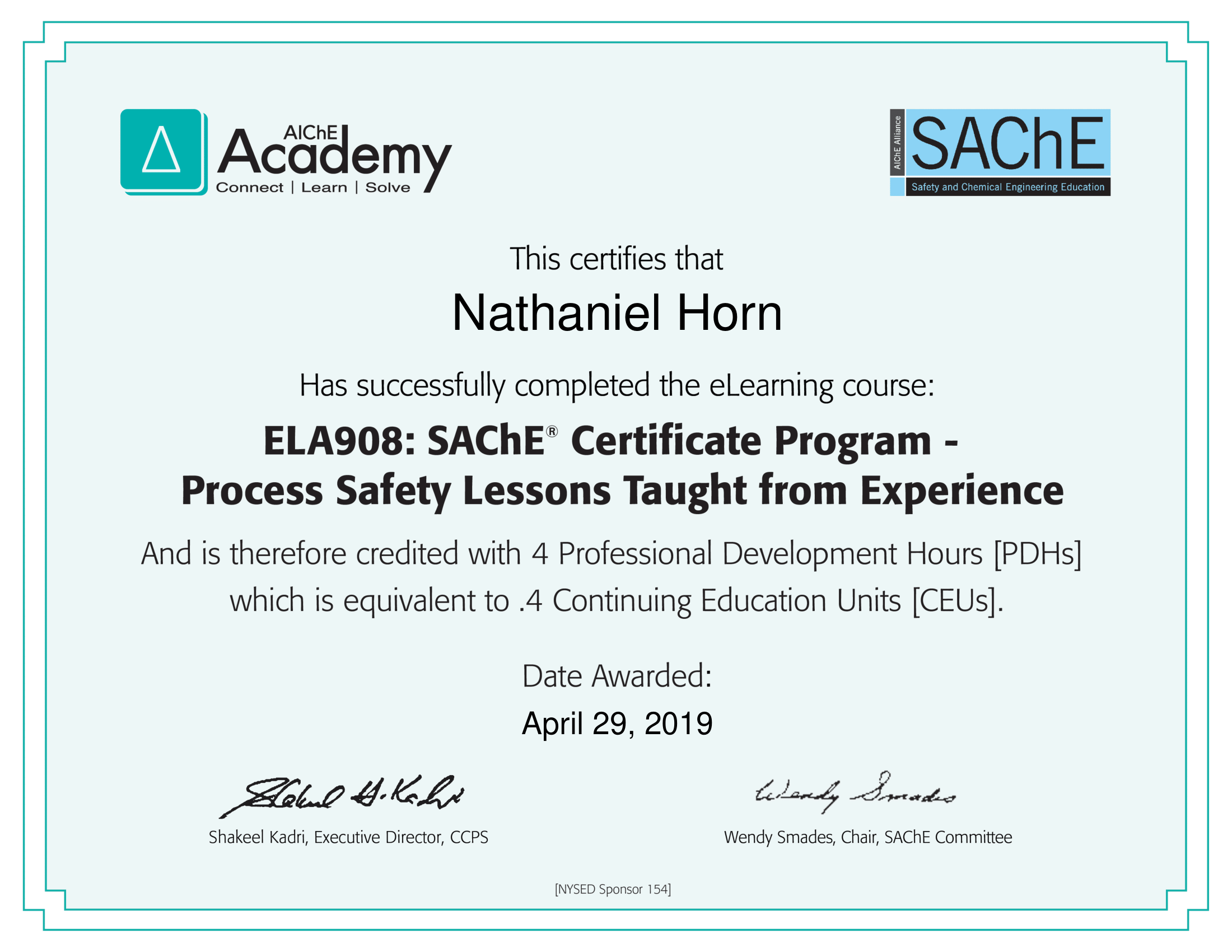
Process Safety I
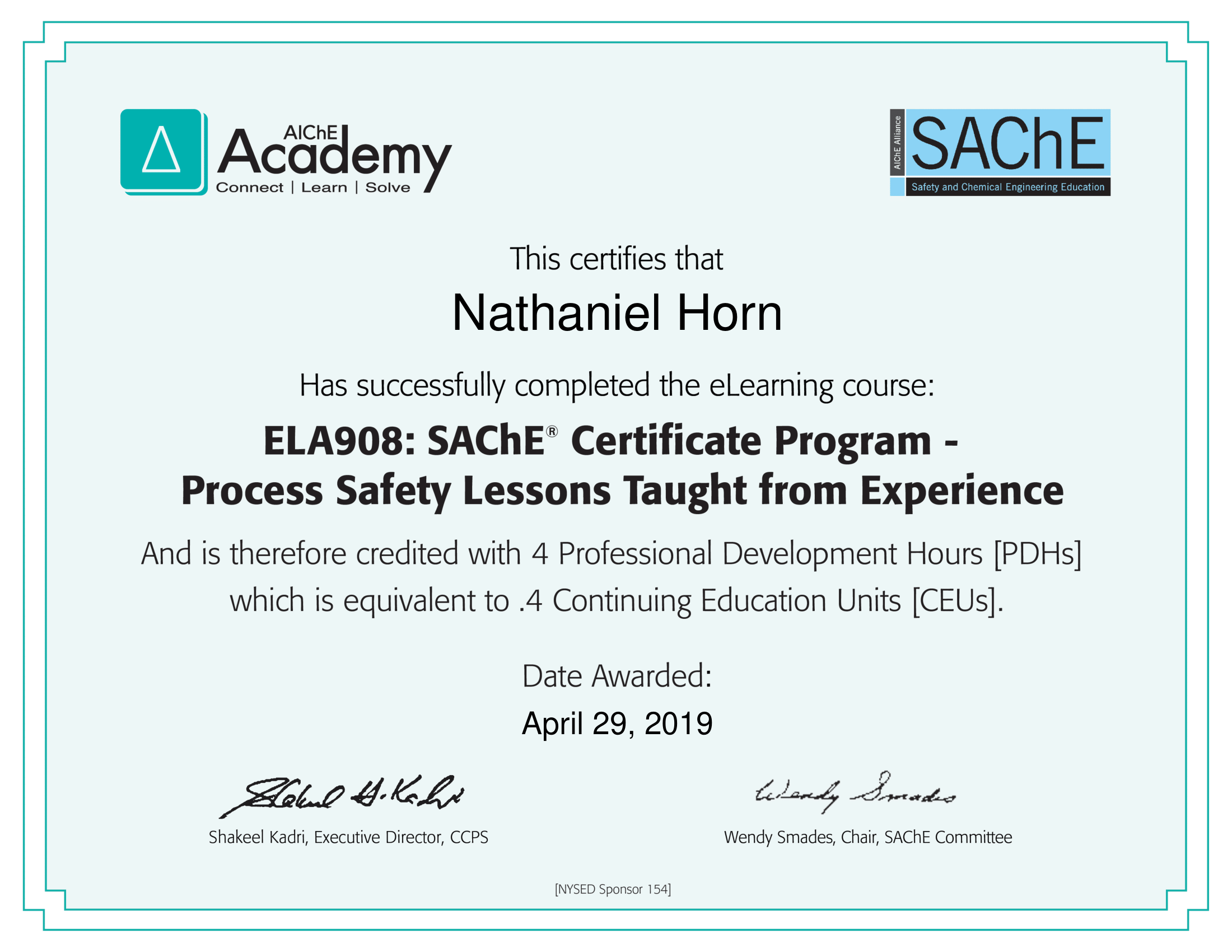
Process Safety II
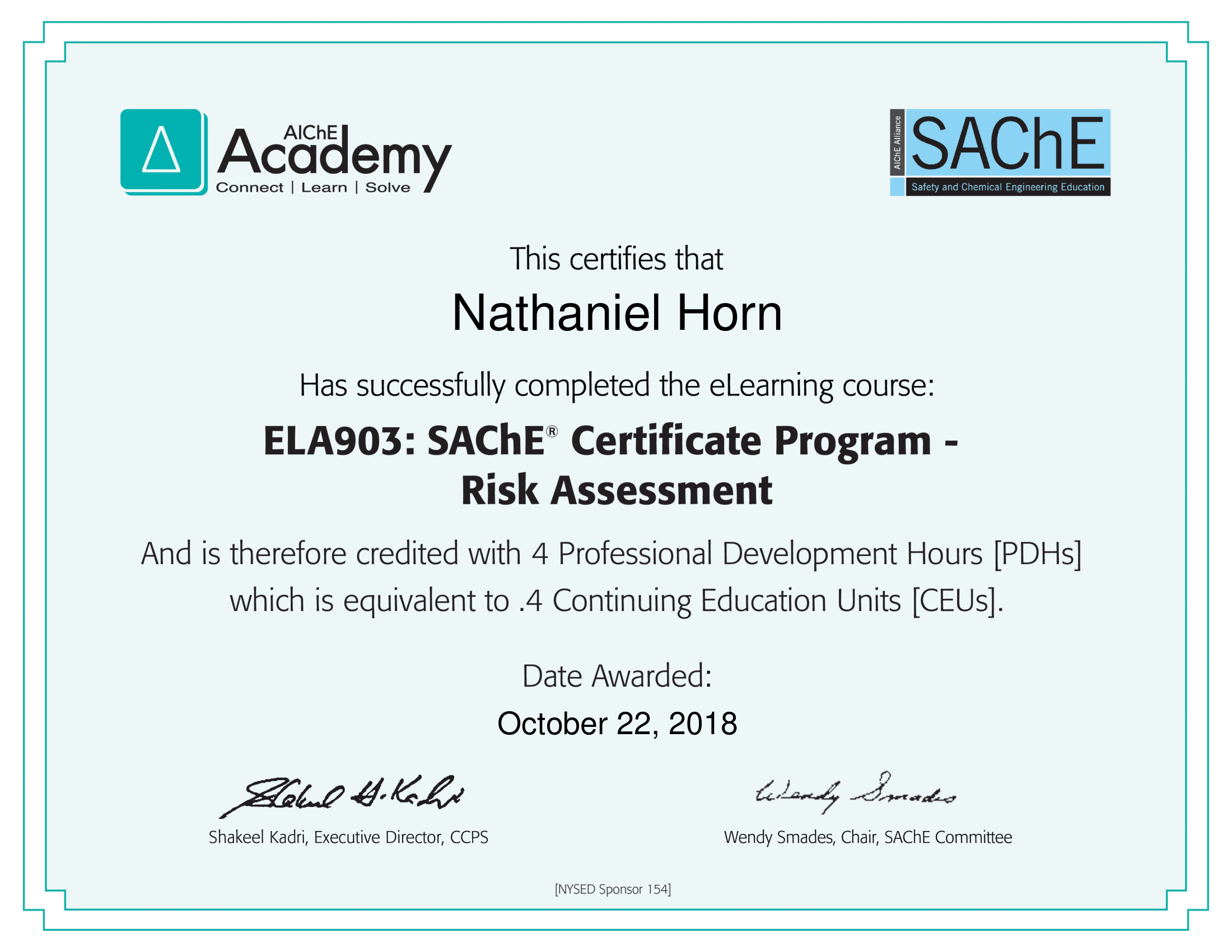
Risk Assessment
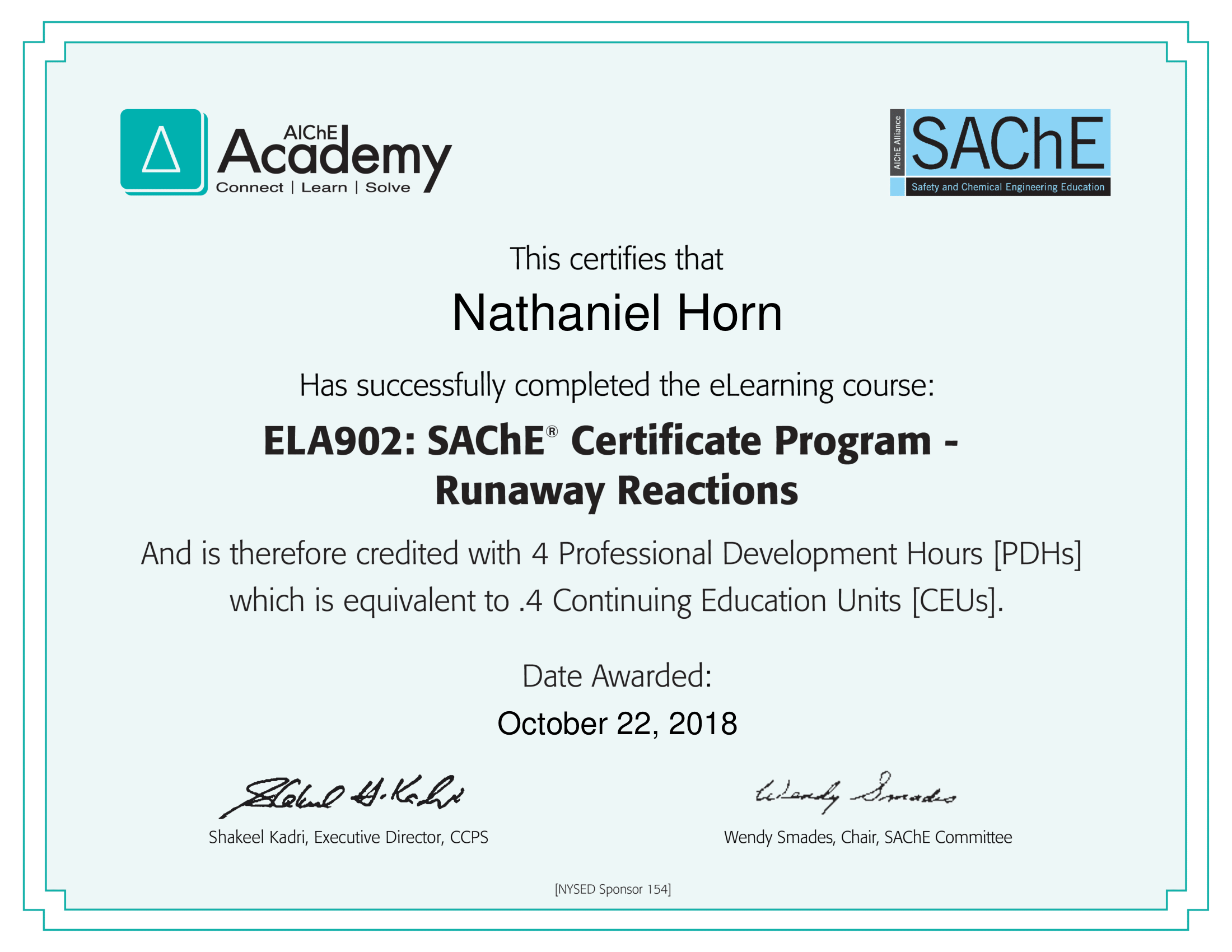
Runaway Reaction
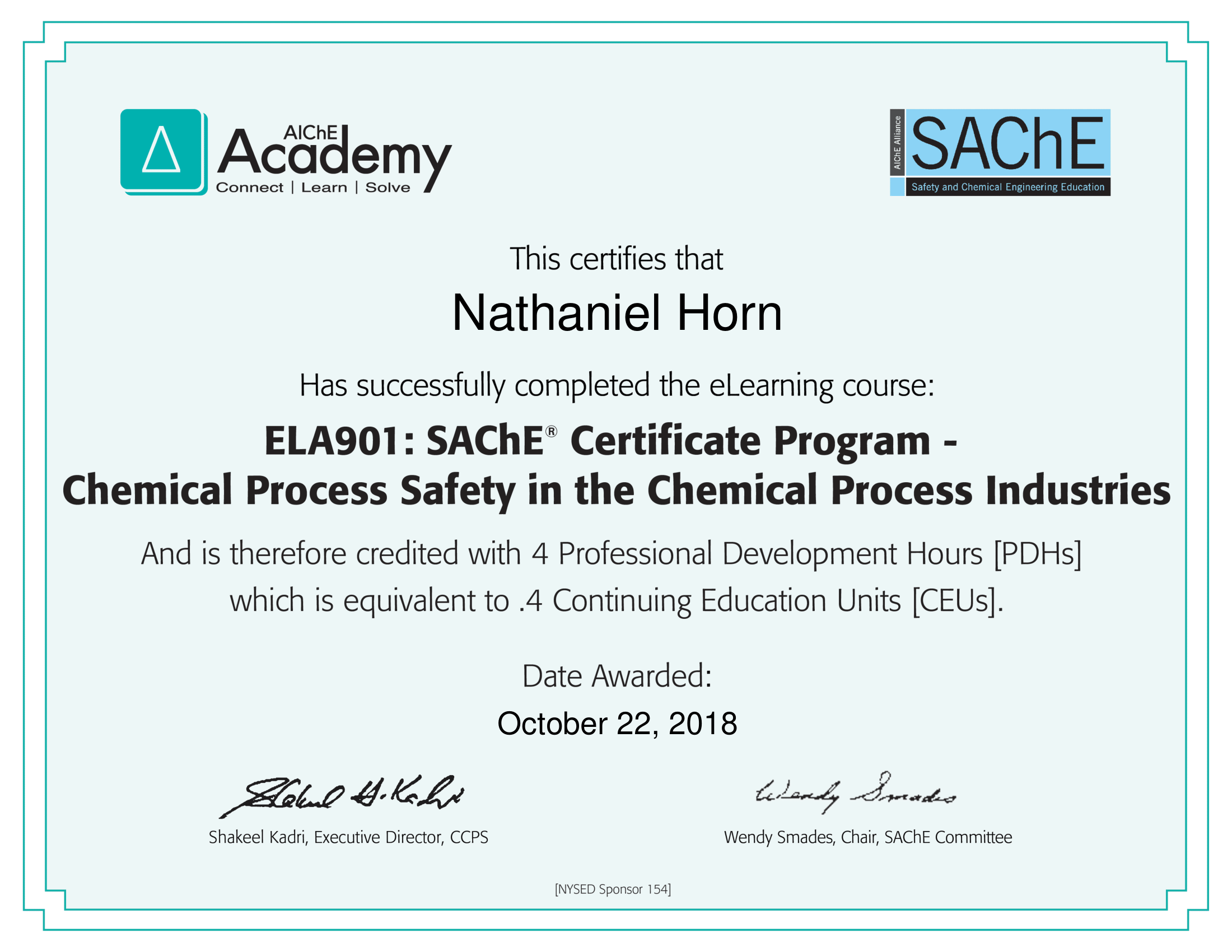
Chemical Process Safety in Chemical Process Industries
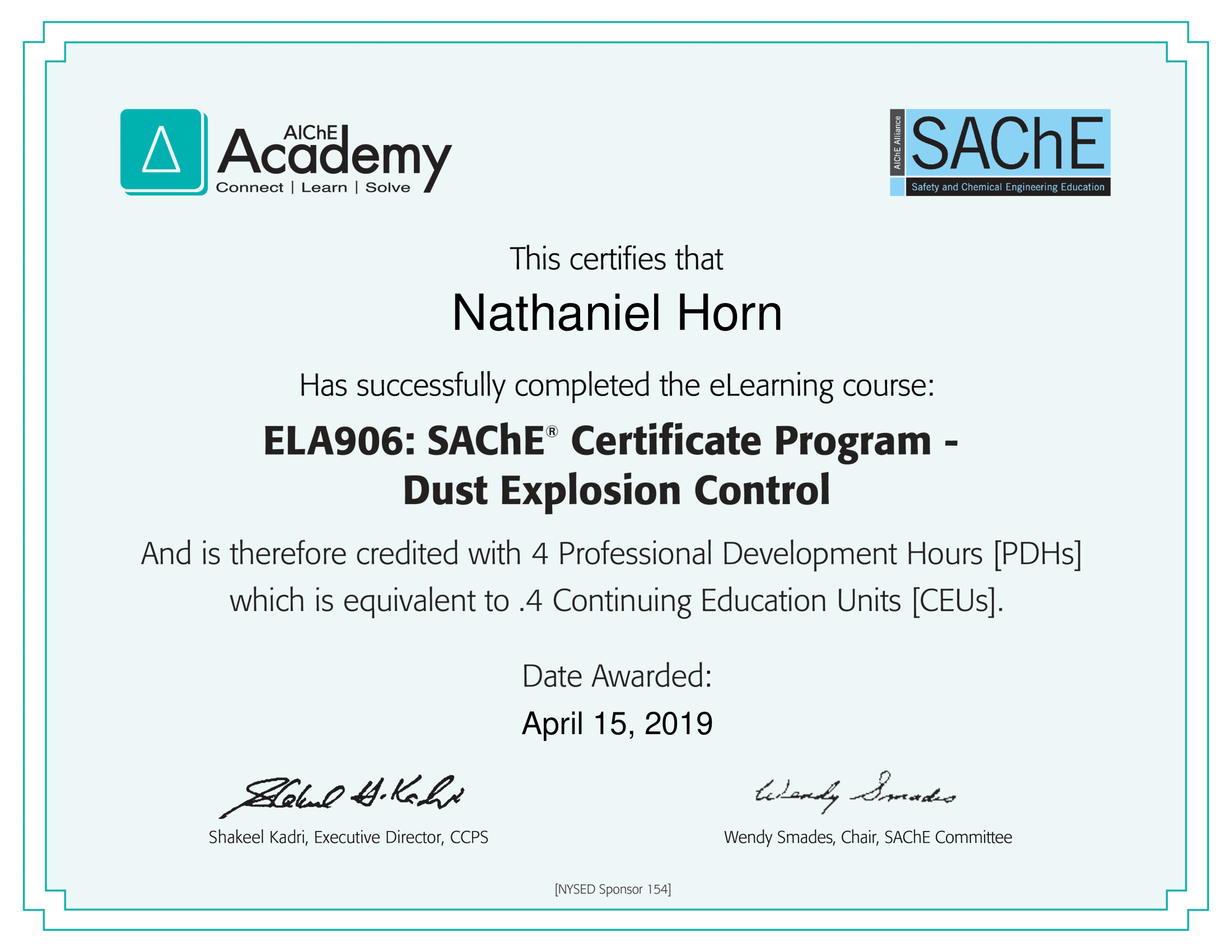
Dust Explosion Control

Hazards and Risks
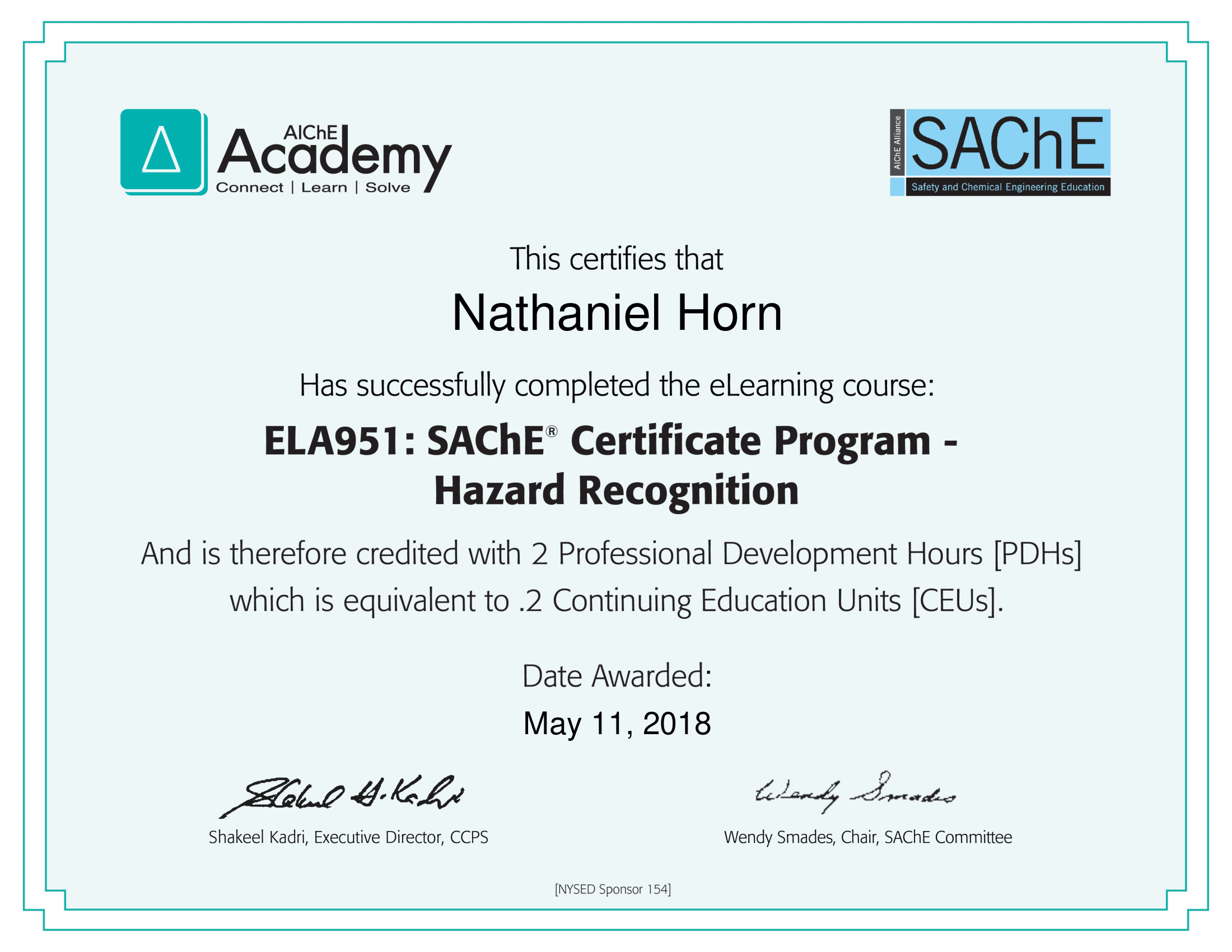
Hazard Recognition
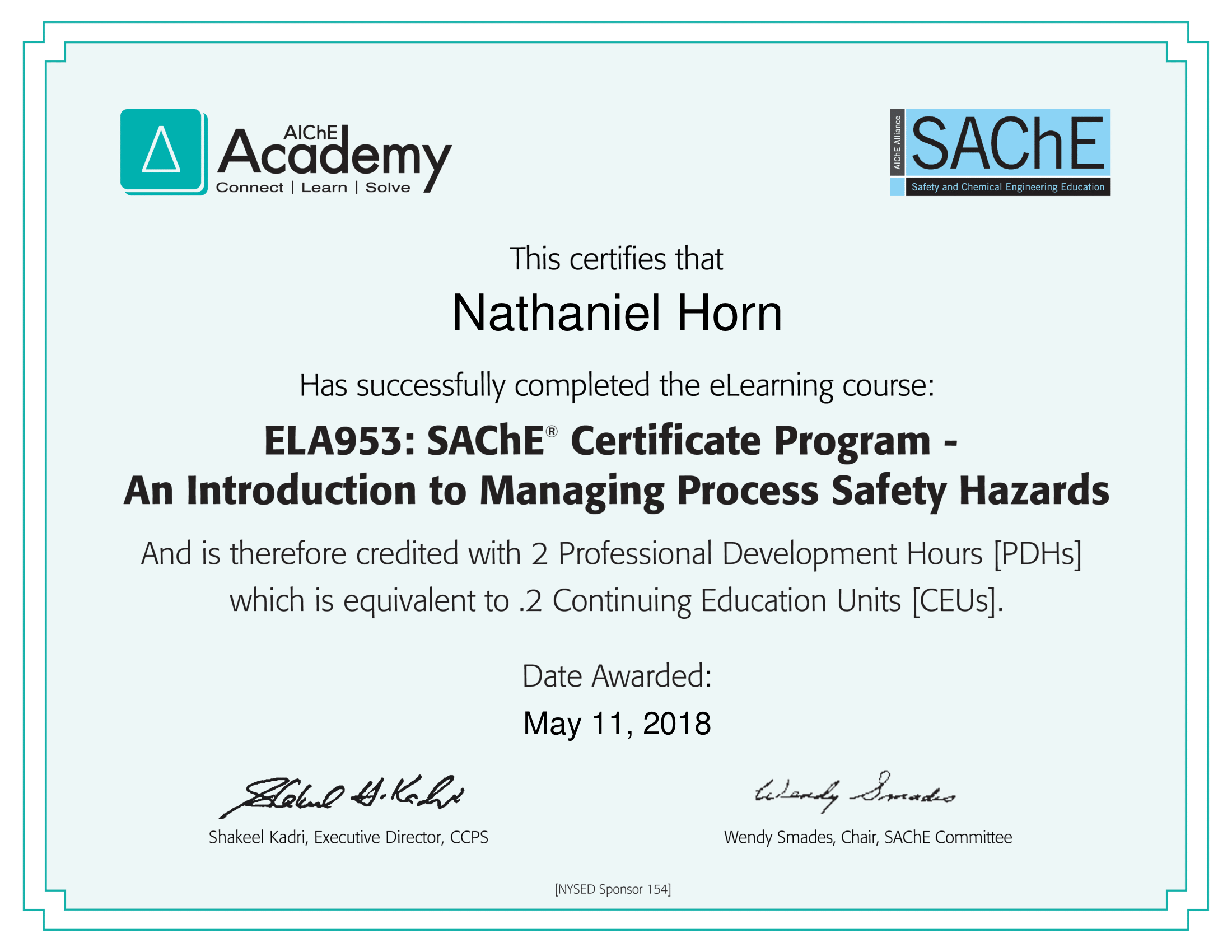
Managing Process Safety Hazards I

Managing Process Safety Hazards II

Open Water Diving

Emergency Medical Technician (EMT)
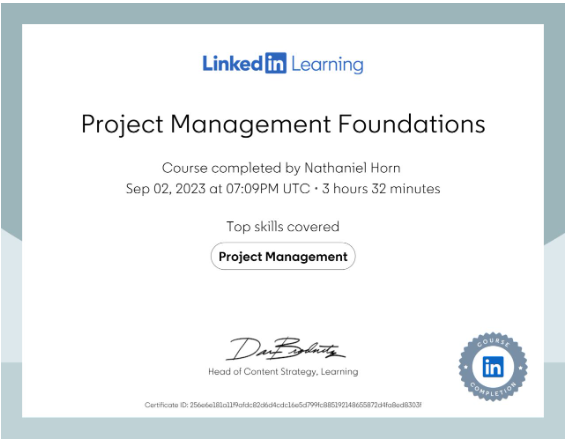
Project Management Foundations
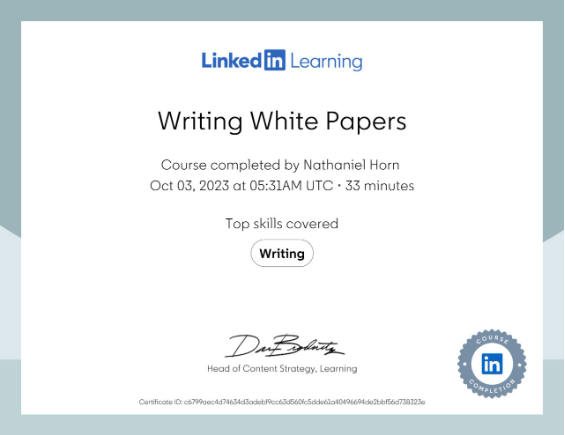
Writing White Papers
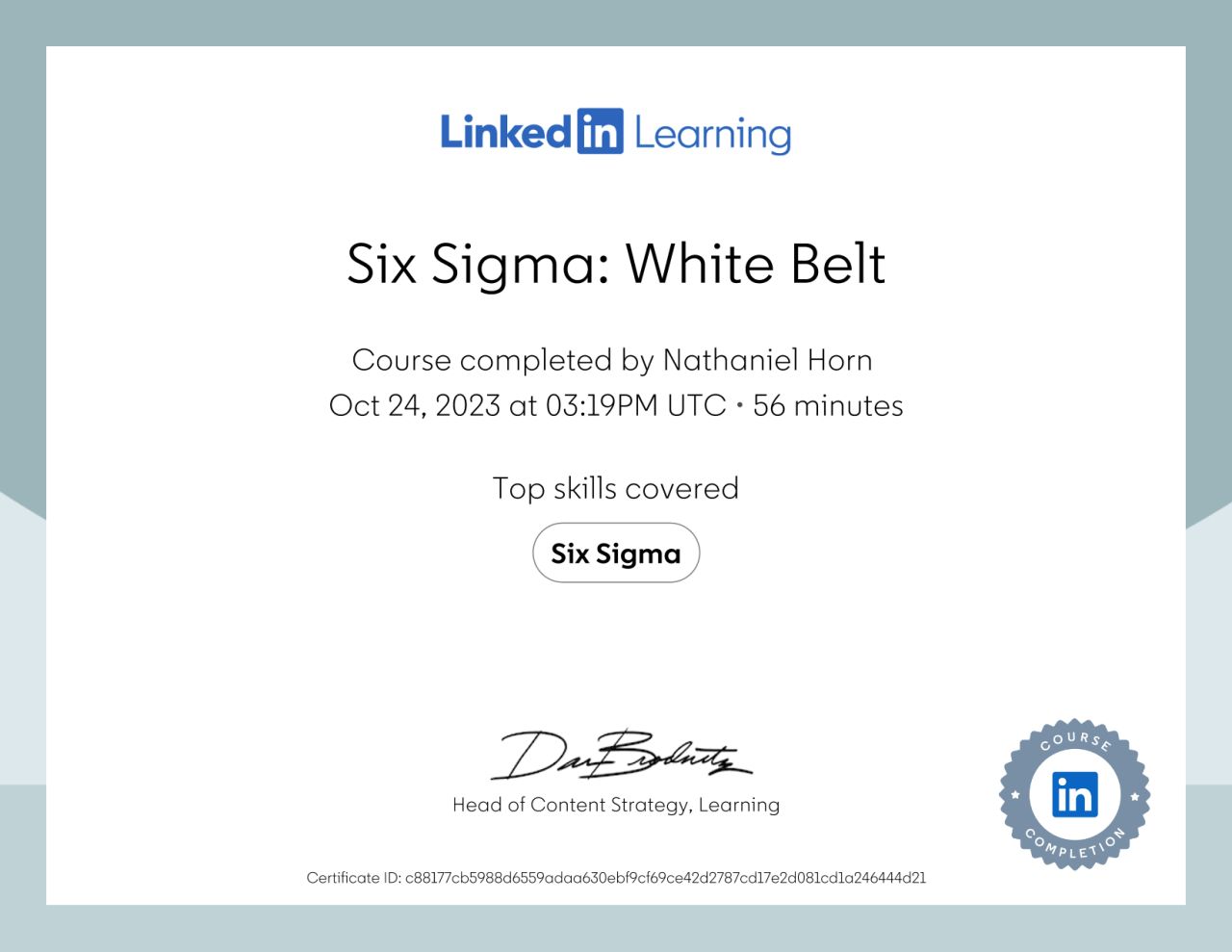
6S White Belt

6S Yellow Belt

Notary Public (FL)

White Paper
Solar panel installation in cul-de-sacs and rental properties.
Nathaniel Horn’s white paper discusses the benefits and enforcement of small and large cities to install solar panels in residential areas. Reducing the consumption of energy produced from fossil fuels.

Paper & Articles
PFAS Contamination Analysis in the United States.
Nathaniel Horn’s paper reviews the contamination of PFAS within the United States through its history, current contamination data, and reasoning for contamination.
Projects
Nathaniel Horn strives to learn and adapt to his surroundings as an engineer and programmer. He will find a way to improve, automate, or re-evaluate a process. Here is a list of projects that Nathaniel has worked on through his career and personal life.
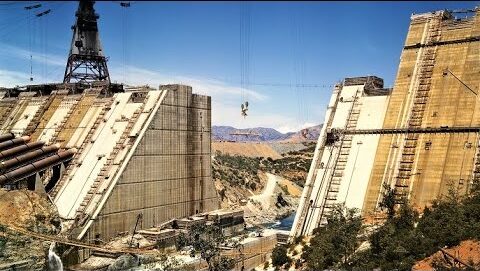
To streamline my role’s reporting and communication processes, I conceptualized and initiated the development of an automated report generation tool leveraging Microsoft Visual Studios and Visual Basic. This utility is designed to interoperate harmoniously with Outlook, Word, and Excel, aiming to save valuable time traditionally spent compiling detailed reports for management.
Drawing on Visual Studios’ flexible environment, I established a system where calendar entries containing individual project updates and plans would automatically transcribe into structured reports, standardizing the process and enhancing readability for management. This eradication of manual paperwork is pivotal, preventing potential errors and fostering efficiency.
Through meticulous programming, the tool can generate professional reports based on templates designed in Word and Excel, which then automatically update in line with calendar inputs. This integration ensures real-time data synchronization across different Microsoft applications, enhancing the tool’s efficiency and accuracy.
A distinguishing feature is its integration with Outlook, where the tool can auto-generate emails appended with the latest reports, ensuring transparent and timely communication with management. This facilitates a seamless, automated workflow from report creation to dissemination, saving precious time while reducing the scope for human error.
As I approach the final stages of this project, I envision it morphing into a versatile project management tool beneficial to a broader audience. Beyond serving my needs, the goal is to hone this tool into a universal solution, universally enhancing efficiency and communication in project management settings.
Skills: Data Analysis · Artificial Intelligence (AI) · Machine Learning · Problem Solving · Data Analytics · Microsoft Power BI · Microsoft Office · reaserch and development · Data analysis · Python · Project Managment
Objective: My project focuses on implementing OpenAI’s guidelines for developing a meeting minutes program powered by auto GPT3 and GPT4. Building upon this foundation, I am developing a comprehensive interface and system that individuals can use on their computers and smartphones to streamline recording meetings and extracting detailed notes.
Key Features:
Effortless Recording: The program simplifies the task of recording meetings, ensuring that every critical detail is captured effortlessly.
Automated Summaries: It generates summaries highlighting key discussion points and action items, making it easy to review the meeting’s essence at a glance.
Attendance Tracking: The system records and tracks meeting attendees, clearly recording who was present during each session.
Task Management: It organizes and categorizes action items, helping teams prioritize and manage post-meeting tasks effectively.
Importance: As someone who understands the importance of taking comprehensive meeting notes, I recognize the critical need for a structured system to exchange and distribute meeting minutes. This ensures that everyone involved is on the same page and clearly understands what transpired during the meeting. By comparing the AI-generated notes with your own, you can establish a solid framework and save valuable time in post-meeting follow-ups.
Benefits:
Efficiency: The system enhances efficiency by automating note-taking and organizing information, reducing manual effort.
Clarity: Clear and concise meeting summaries help prevent miscommunication and promote a shared understanding of meeting outcomes.
Time-Saving: Comparing AI-generated notes with personal notes streamlines the review process, allowing for quicker decision-making and action item follow-ups.
Skills: Data Analysis · Artificial Intelligence (AI) · Audio Analysis · Machine Learning · Data Analytics · Python (Programming Language)
I was responsible for creating a new manufacturing system, aiming to improve the organization, streamline processes, and lower costs. This involved designing a system that could strike a balance between the United States’ common MRP (Materials Requirements Planning) system and the Kanban system while also accounting for the specific needs of our factory. To meet these objectives, I conducted extensive research and analysis, reviewing the existing manufacturing processes, identifying inefficiencies, and determining the areas where improvements could be made. I then developed a comprehensive plan that included reorganizing the factory layout and establishing proper procedures to optimize the flow of materials and products. In addition to these operational changes, I created a new system that utilized the best practices of both MRP and Kanban, tailored to the specific needs of our factory. I ensured that this new system could be easily modified and adapted to meet changing requirements, allowing us to respond quickly to shifts in demand or production needs. Throughout the project, I collaborated with cross-functional teams to ensure buy-in and smooth implementation of the new system. I also provided training and support to our team members to ensure they understood the latest procedures and could use the system effectively. As a result of this project, our factory saw significant efficiency and cost savings improvements, with the new system allowing us to manage inventory better, reduce waste, and improve overall productivity.
Skills: Data Analysis · Problem Solving · Scopes Of Work · Public Speaking · Communication · Data analysis · Presentation
Guiding a team consisting of the vehicle’s owner, mechanics and a fellow car enthusiast, I led the rejuvenation of a 1965 Mustang, a symbol of American automotive heritage. Our collaborative effort, informed by a deep understanding of car engineering, involved a series of carefully planned and executed stages to return the classic vehicle to its original grandeur.
In the initial phase, I oversaw the meticulous disassembly and examination of the engine, the centerpiece of the Mustang. Collaborating with specialized metal workshops, we ensured the vital engine components were refurbished to align with the original specifications while enhancing longevity. This stage also involved in-depth research to find high-quality replacements for worn-out parts, marrying tradition with modern functionality. Following the engine restoration, we implemented a sophisticated rust prevention strategy, utilizing modern techniques and materials to guard against future corrosion and maintain the car’s integrity. An educational component was central to this stage, with the owner and team members learning to identify early rust signs and how to counteract them. Post-restoration, I designed a maintenance protocol for the owner, offering guidance on the regular upkeep necessary to preserve the vehicle’s condition, addressing the unique needs of a vintage car, and fostering a sense of empowerment and readiness to keep the Mustang in peak condition for years to come.
This restoration journey, a blend of technical skill and teamwork, was as detailed as it was rewarding, with every step fostering a deeper connection to the iconic vehicle. It was a proud moment to witness the resurrected 1965 Mustang, now a beacon of timeless elegance and robust performance, ready to retake its rightful place on the road.
Skills: Data Analysis · Problem-Solving · Scopes Of Work · Internal Combustion Engines · Customer Service · Engineering
At the esteemed annual poster presentation hosted by the American Institute of Chemical Engineers (AIChE) at the University of New Hampshire, my collaborative team undertook the ambitious challenge of conceptualizing a Dimethyl Ether production facility that stands as a paragon of efficiency, economy, safety, and environmental sustainability. Leveraging a synergy of creativity and innovation, we forged a blueprint that was not only eco-friendly but remarkably cost-effective.
Our concerted efforts culminated in a presentation where we unveiled our groundbreaking design to a panel of industry connoisseurs, demonstrating the intricate balance we had achieved between economic viability and environmental responsibility through rigorous economic analysis. The panel resonated with our forward-thinking approach, crowning us with the prestigious first-place accolade in the UNH Department of Chemical Engineering’s student poster presentation. This accolade is a testimony to our unyielding dedication and meticulous approach and reinforces our commitment to spearheading sustainable and innovative solutions in the chemical engineering landscape. At the esteemed annual poster presentation hosted by the American Institute of Chemical Engineers (AIChE) at the University of New Hampshire, my collaborative team undertook the ambitious challenge of conceptualizing a Dimethyl Ether production facility that stands as a paragon of efficiency, economy, safety, and environmental sustainability. Leveraging a synergy of creativity and innovation, we forged a blueprint that was not only eco-friendly but remarkably cost-effective. Our concerted efforts culminated in a presentation where we unveiled our groundbreaking design to a panel of industry connoisseurs, demonstrating the intricate balance we had achieved between economic viability and environmental responsibility through rigorous financial analysis. The panel resonated with our forward-thinking approach, crowning us with the prestigious first-place accolade in the UNH Department of Chemical Engineering’s student poster presentation. This accolade is a testimony to our unyielding dedication and meticulous approach and reinforces our commitment to spearheading sustainable and innovative solutions in the chemical engineering landscape.
Skills: Data Analysis · Problem Solving · Report Writing · Scopes Of Work · Piping and Instrumentation Drawing (P&ID) · Flow Diagrams · Data Analytics · Technical Writing · Design Specifications · Analytical Skills · Process Design · Chemical Engineering · Public Speaking · Engineering · Communication · Data analysis · Presentation · Project Management
During my senior year of high school, I spearheaded an ambitious independent research project under the mentorship of a seasoned teacher, keen on unraveling the viability of hydrogen fuel cells as a sustainable source of power for engines. Immersed in exhaustive research, I delved into the intricacies of fuel cell technology, leading to the hands-on phase where I conceptualized, designed, and put to test several iterations of modified engines and fuel cells. Through a meticulous and iterative process of trial and error, I reached a pivotal milestone — successfully operating an engine using a hydrogen fuel cell. Despite the victory, the results leaned towards the inefficiency of the method compared to established fuel sources. This endeavor fortified my problem-solving, research, and experimental design skills and laid a robust groundwork for my current pursuits in the engineering field, with a deep-seated understanding of the dedication and precision that complex projects demand.
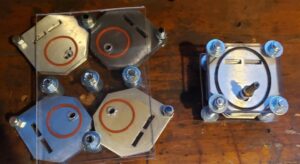
GitHub (Amlis Sanches)
Review Nathaniel's programs that are publicly avalible.

BLog
Review Nathaniel's Story's, ideas, articles and more.
LinedIn
Connect with Nathaniel on LinkedIn.
